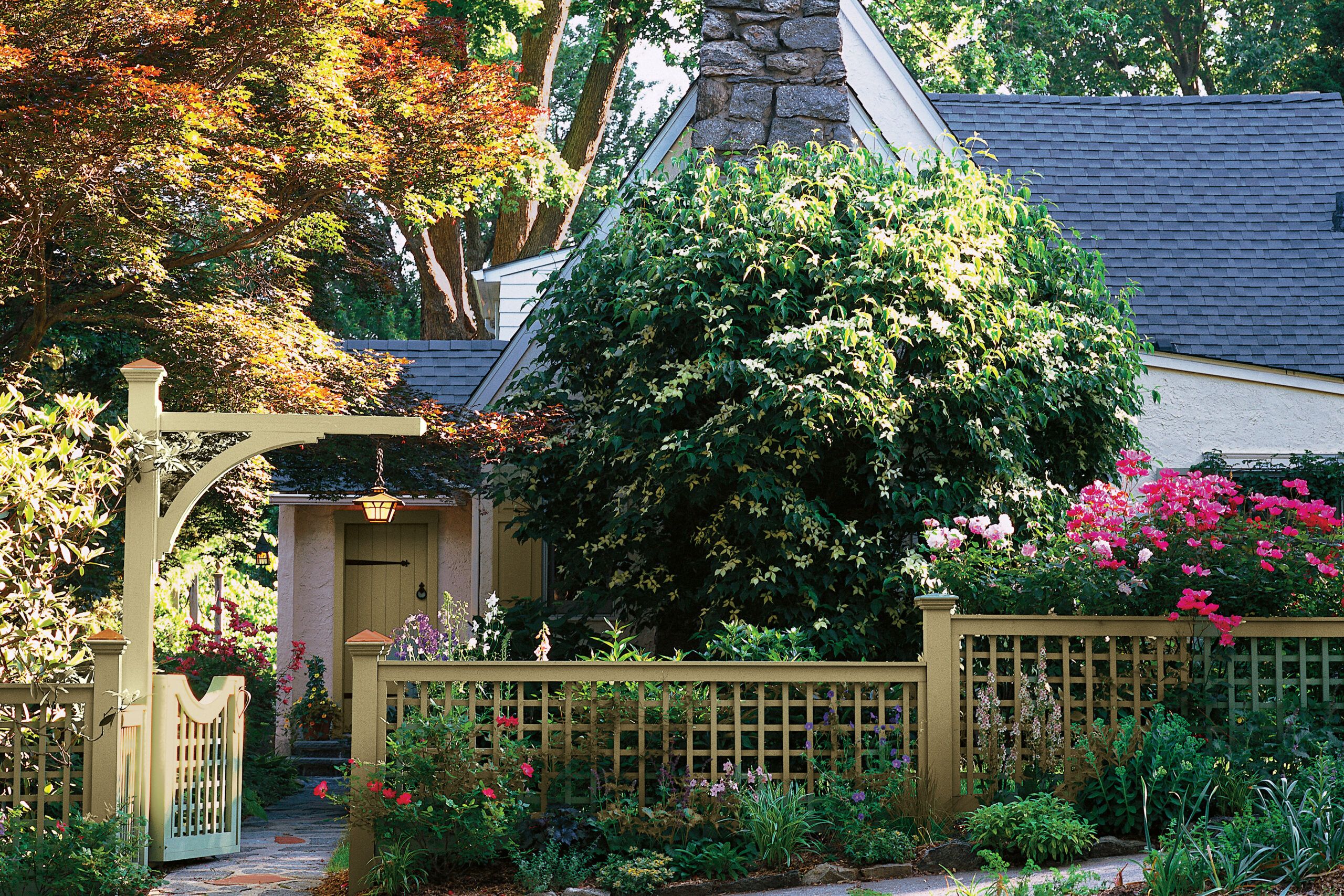Creating a small yard with a big impact is all about maximizing space with design. By carving out distinct garden areas and outdoor rooms, you can create a feeling of expansiveness in even the most compact spaces. With careful planning and creative design, you can transform a small yard into a stunning outdoor oasis that feels much larger than its actual dimensions.
Design Tips for Small Yards
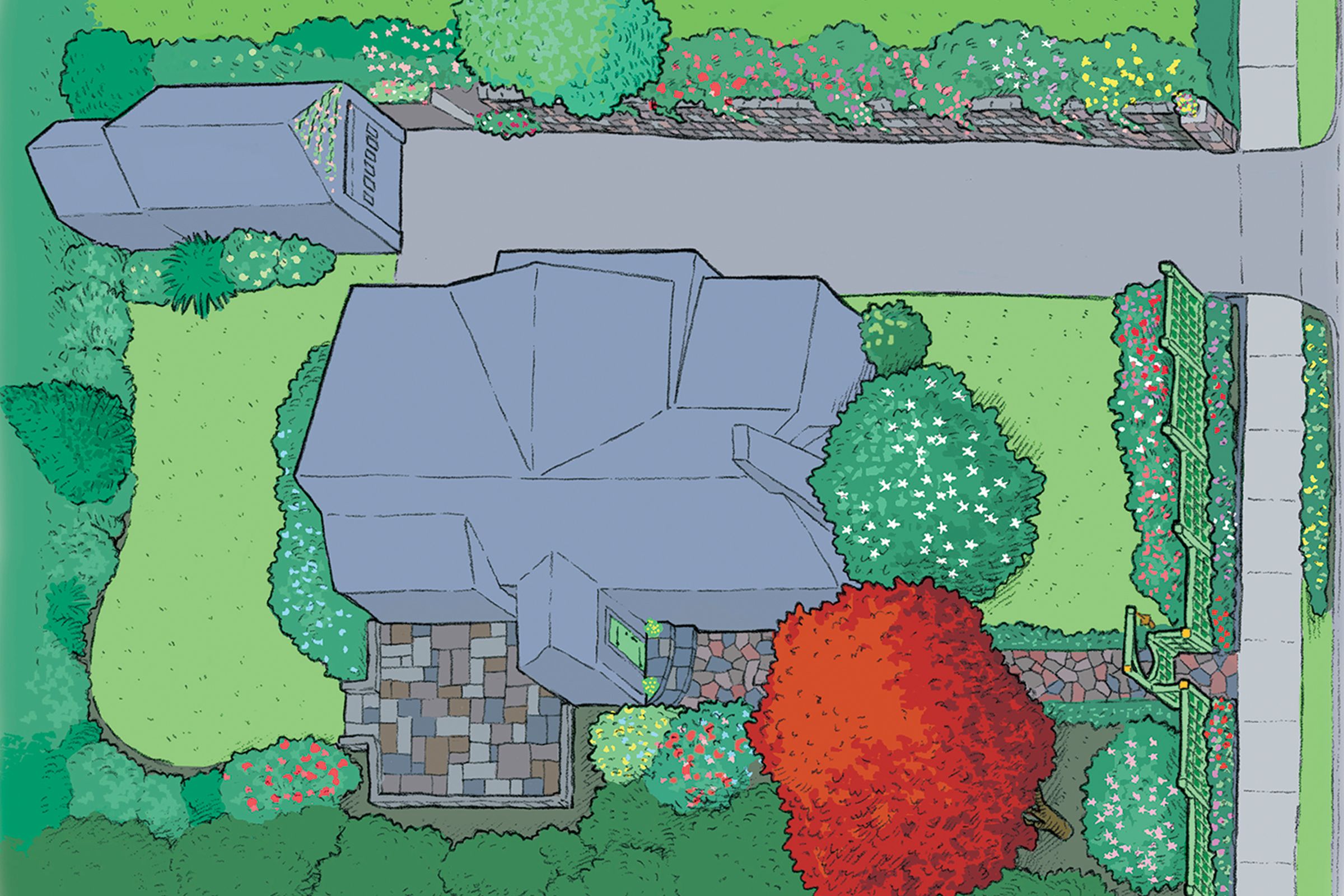
When designing a small yard, make every inch count. Pay special attention to hardscape features such as fences, walls, and paved areas, ensuring they have the right scale and proportion. These elements, along with established trees and shrubs, will provide structure year-round and help define your outdoor spaces.
To maximize impact, consider the following design tips:
- Layer plants of various heights, colors, and textures to add depth
- Choose varieties with successive flowering times for continuous blooms
- Personalize your home’s exterior with hardware, lighting, and trellises that tie into the landscape
- Plan and plant with views from inside the house in mind
- Illuminate the garden at night to extend its usability and visual appeal
Remember to put your front yard to work in establishing a mood. For example, an English cottage-style garden can complement a cozy Tudor Revival house, creating a cohesive look that extends from your home to the landscape.
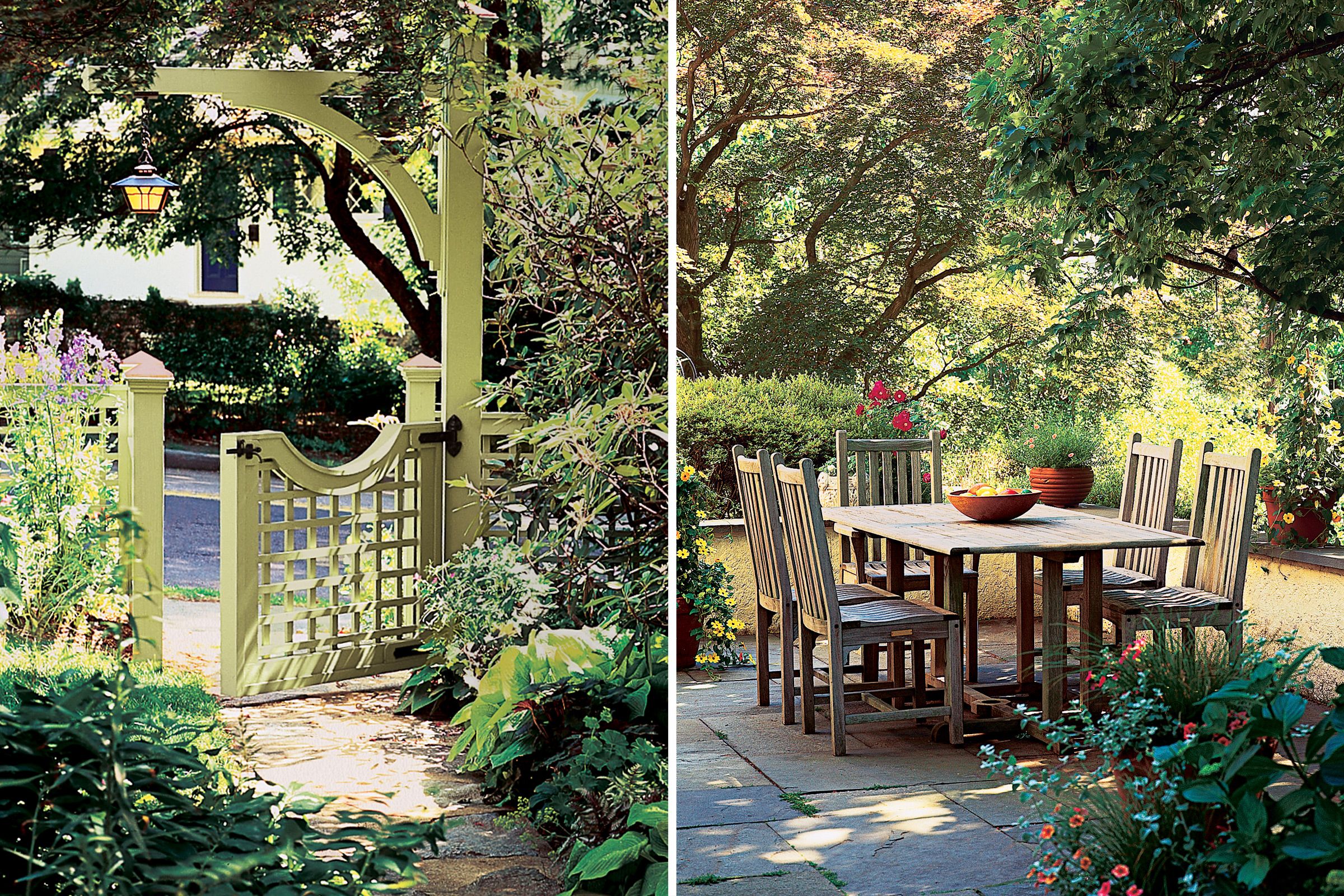
Create an intimate entry garden
arch or exaggerated lamppost can make a visual connection between the landscape and the house, signaling where to enter. Soften these structures with plants like Japanese red maple or rhododendron to blend them into their surroundings.
The paving should also reflect the style of your home and garden. For example, irregular, multicolored pieces of slate can complement a 1920s house while creating a casual pathway for an informal cottage garden. Line the path with shade-loving plants like hostas and Japanese painted ferns in shadier areas, and sun-loving plants like hydrangeas and roses where there’s more light.
A well-constructed garden gate can add both functionality and charm to your entry garden. Here are three types of garden gate hardware that provide sturdy support:
Types of garden gates
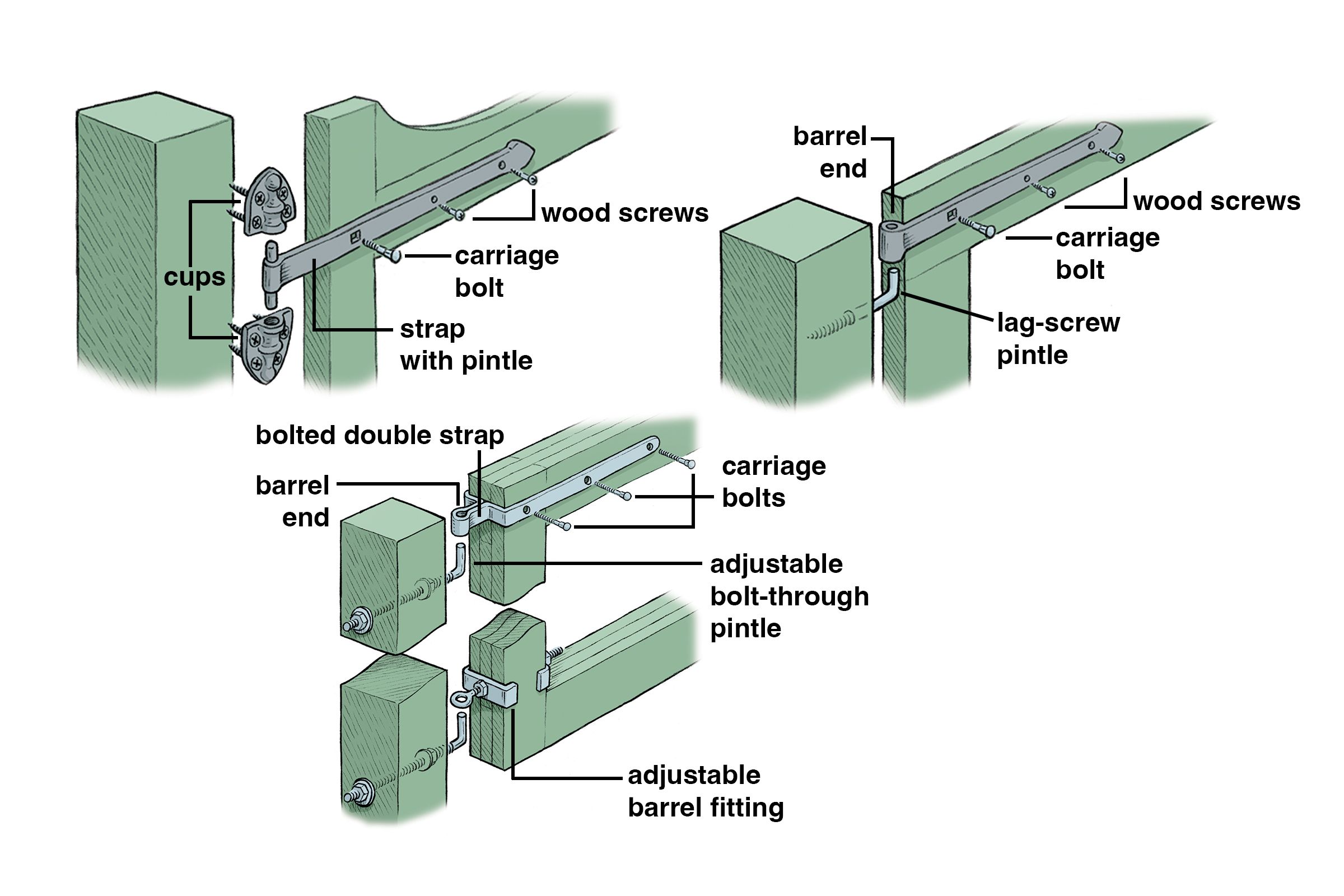
Sturdy construction is key to preventing a sagging gate. And so is the right hanging hardware, usually a pair of sturdy strap hinges sized to cover one-fourth to one-third of the gate’s width. Here are three types of garden plates you can use:
1. Surface mounted, with a cupped pintle: On the decorative galvanized steel hinges used in some projects, the pin (or pintle) is part of the strap, which is attached with a carriage bolt and wood screws. The bottom “cup” is screwed to the face of the post, and the pintle is set into it. Another cup covers the pintle top and is screwed in, making for a very rigid hinge that can carry up to 150 pounds.
2. Open-topped, lag-screw pintle: A J-shaped pintle is lagged into the side of the post ready to receive the barrel end of the strap. This most basic style allows for more swing and makes the gate easy to remove.
3. Bolted double strap: For the heaviest-duty field or driveway gates, a double strap wraps both sides of the stile and rail; the pintle is bolted through the side of the post. The bottom fitting adjusts easily if the gate gets out of kilter.
Build a walled stone patio
For a 14-by-18-foot paved area, consider using cut bluestone pavers of different sizes laid in a random pattern. A dry-set installation allows for a more informal look, with volunteer flowers and moss creeping up through the joints.
To define the space and add privacy, consider building a low perimeter wall made from concrete block and finished with stucco and a bluestone cap. Create a sense of intimacy by incorporating a woodland edge of trees, shrubs, ferns, and shade-loving ground covers as a buffer, while still allowing light and air to filter through.
For added color and interest, use medium-height flowering shrubs like hydrangea, summersweet, and azalea along the edges of the patio. Incorporate potted herbs, ornamental plants, and climbing vines in terra-cotta containers to provide even more visual appeal and functionality.
Add an ornamental border
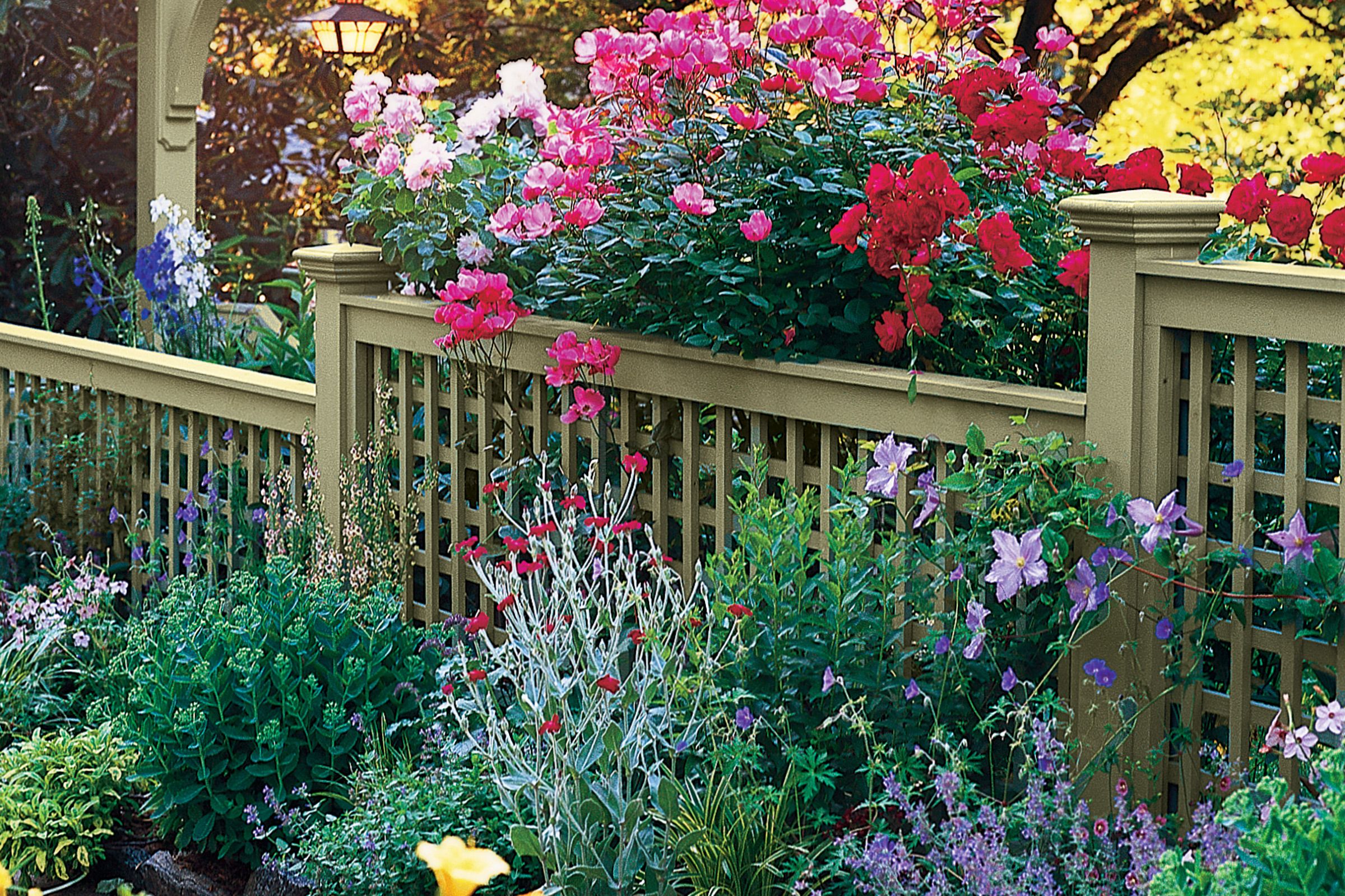
An ornamental border along the front of your property can create a frame for your garden, provide year-round interest, and offer privacy. Consider installing a fence with an English lattice pattern for a charming, cottage look. This type of fence serves as an excellent backdrop for a long-blooming perennial border.
When planting your border, arrange low-growing plants on the street side and taller ones on the house side. This creates depth and visual interest while hiding the unattractive lower limbs of tall flowering shrubs.
Some plant suggestions include:
- Street side: Creeping phlox, cranesbill, heuchera, iris, Japanese painted ferns, low-growing roses, penstemon, red valerian, rose campion, salvia, sedum, snow-in-summer, daylilies, and clematis
- House side: Allium, butterfly bush, delphinium, false indigo, foxglove, hollyhocks, lilies, peonies, and various rose varieties
Fence panels

While premade wooden fence panels are readily available, building your own allows for customization and the use of premium lumber. Here’s a brief overview of how to construct custom fence panels:
- Create a frame with top and bottom rails and side cleats.
- Attach horizontal lattice battens to the side cleats.
- Staple vertical battens to the horizontal ones.
- Sandwich the lattice between two frames.
- Install the panels between fence posts.
- Add rail caps and post caps for a finished look.
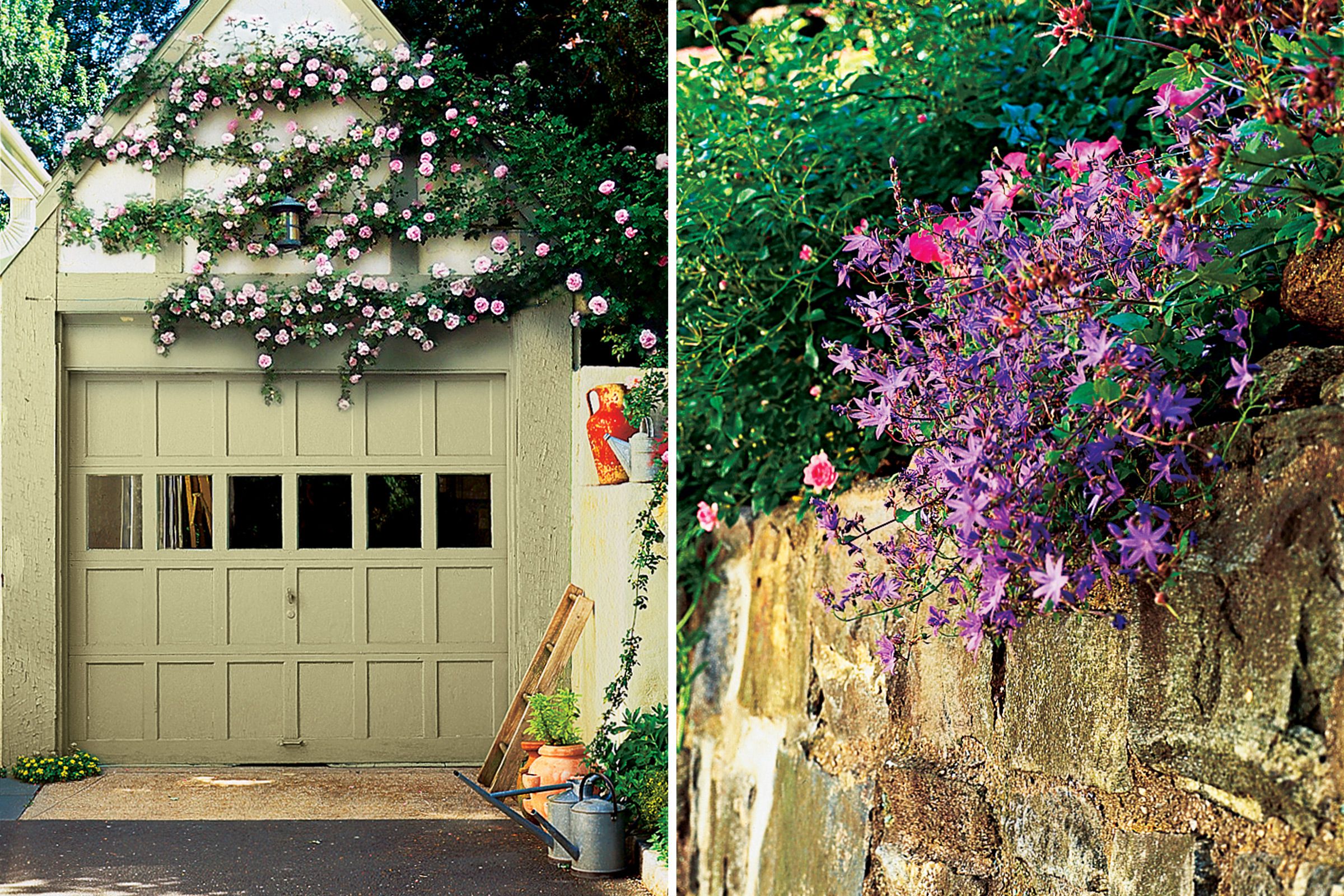
Train climbers up a wall
Vertical gardening is an excellent way to maximize space in a small yard. Use the walls of your house or outbuildings to grow climbing plants like roses or vines. For plants that don’t naturally cling, such as roses, provide support using heavy-gauge copper wire strung through masonry eye screws attached to the building’s surface.
Consider using ready-made cedar trellises attached to the house to support climbing roses and clematis vines. This approach not only adds visual interest but also helps to integrate your home’s architecture with the surrounding landscape.
Grow trailers down a wall
Retaining walls are common in many yards and can be softened with cascading plants. This technique puts flowers at eye level and allows you to appreciate pendulous blossoms like bleeding heart, helleborus, and spiderwort from below.
For areas that are difficult to access or receive intense sunlight, choose low-maintenance plants such as:
- Catmint
- Evergreen juniper
- Fairy roses
- Lavender
- Montauk daisy
- Poppy mallow
- Purple campanula
- Santolina
- Sedums
- Willowleaf cotoneaster
These plants thrive with minimal care, and some, like lavender and santolina, even emit pleasant fragrances. They also provide year-round interest and help fill in gaps where other plants might struggle.
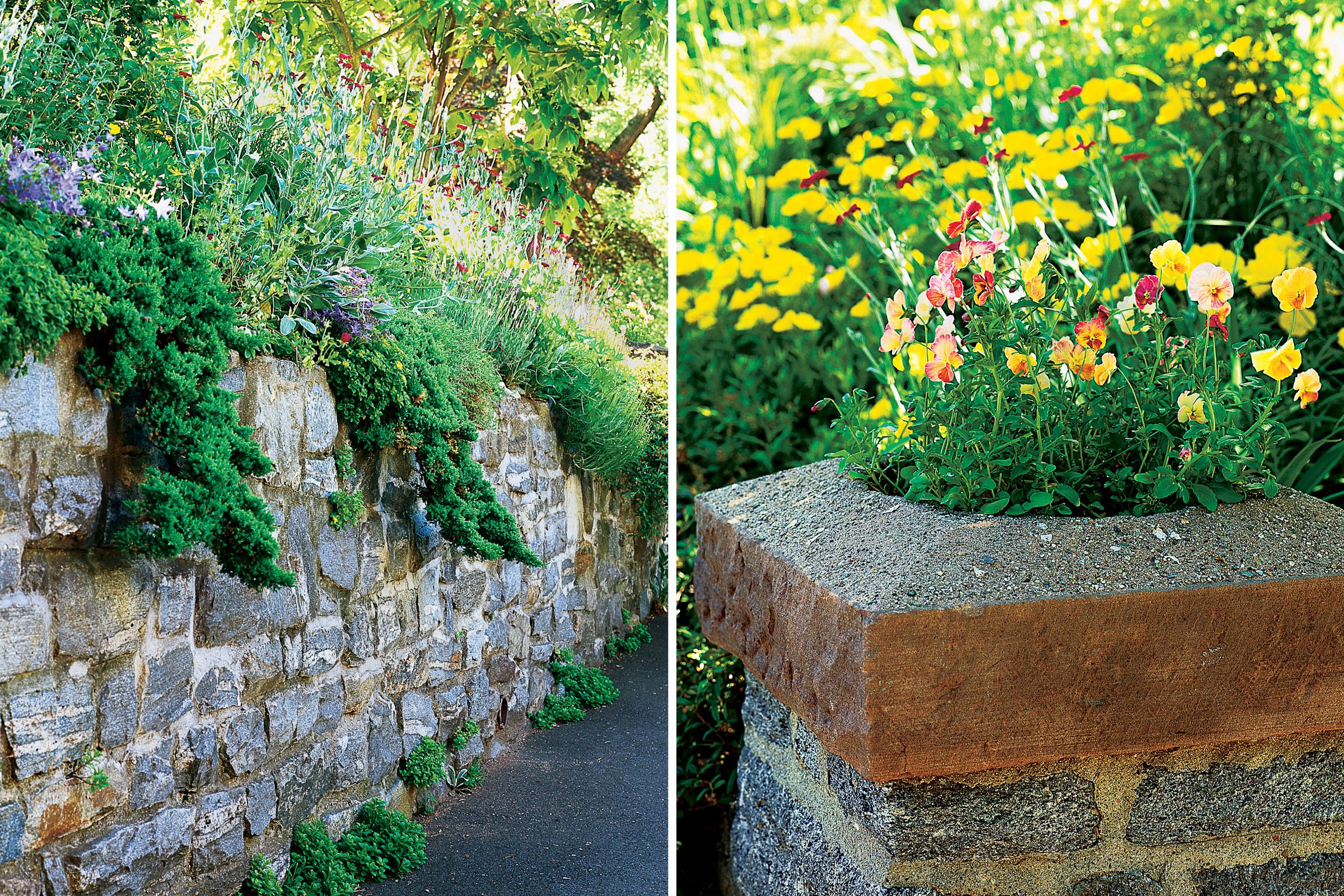
Create tiers
Creating tiers in your garden adds depth and visual interest to a small space. Use larger plants as a backdrop for drifts of smaller flowers in front. Employ a mix of textures and colors to create dynamic compositions that change with the seasons.
Consider including:
- June-flowering pink rugosa roses
- Late-summer large-petaled hibiscus
- Mounding ornamental grasses
- Spring-blooming yellow broom
Put in a stone planter
Low pillars often punctuate a driveway entrance or the ends of a wall. Turning the top into a planter is another chance to brighten a site with flowers and foliage. This stone-and-concrete column has a cast-concrete cap with an integral planting bowl about the size of a 14-inch clay pot. And like a clay pot, it needs regular watering to ensure that the plants do not dry out.
Each year we plant the pillar with annuals for lots of color. Cool-weather-hardy pansies are put in first in early spring, as soon as they’re available. When the weather warms up, they get replaced with whatever looks great on the day we go to the nursery. For a lower-maintenance planting in full sun, consider drought-tolerant sedums, succulents, or ornamental grasses.
How to build a pillar planter
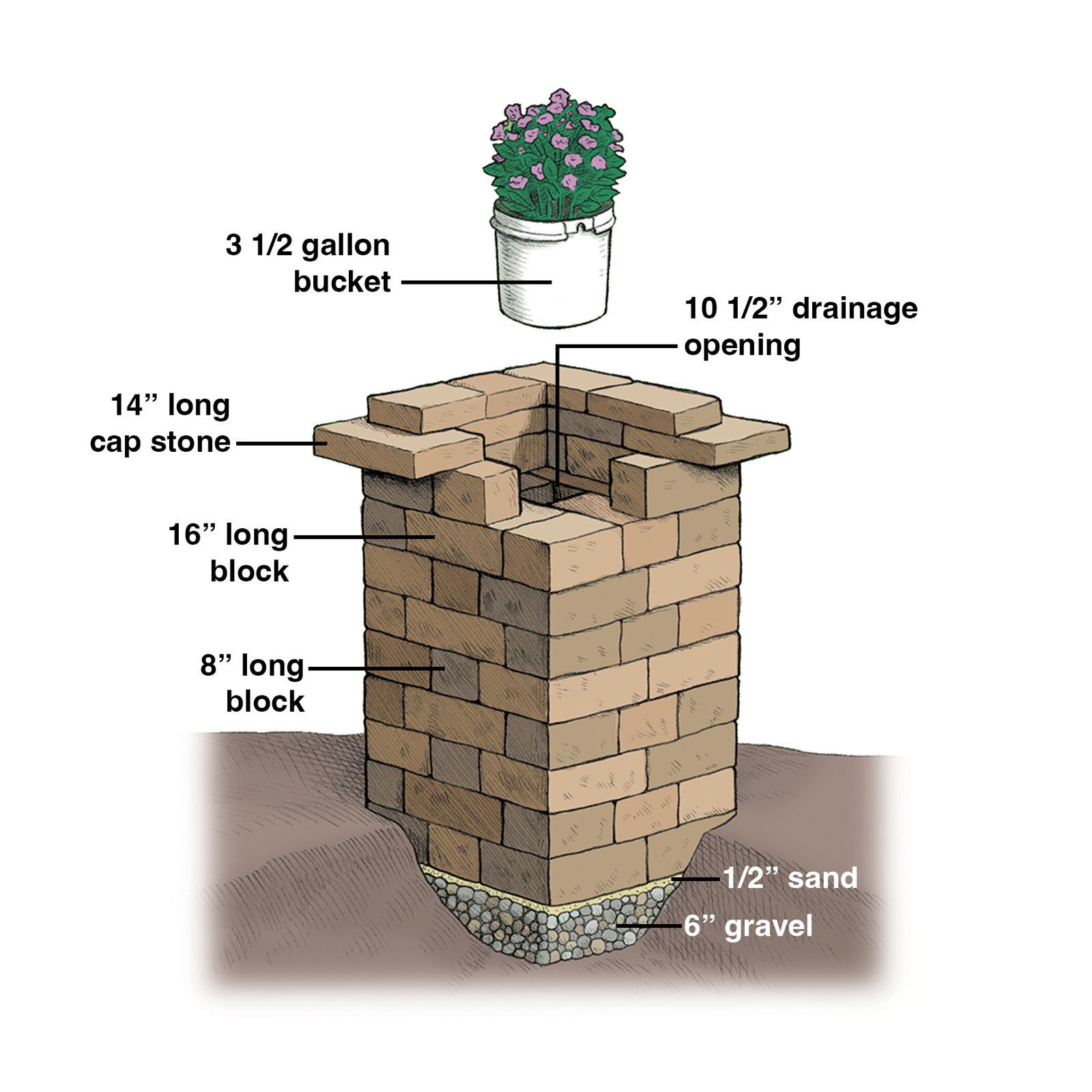
A stone planter can add a decorative element to your garden while providing another opportunity for plants. Consider building a pillar planter using precast concrete retaining wall blocks. Here’s a simplified guide to creating a 32-inch square, four-foot high planter:
- Excavate a foot of soil, then add 6 inches of tamped crushed stone; top with 1/2 inch of sand.
- Lay your first course, alternating 16- and 8-inch-long blocks to create the pattern shown here; level it.
- Apply concrete adhesive along the tops of the blocks, then start the second course, offsetting joints with large and small blocks as needed. Top with adhesive — and so on, for a total of eight courses.
- On the ninth row, knock 3 inches off the inside of each 12-inch-deep block to make room for a 3 1/2-gallon plastic bucket to sit on the rim of the void in the column’s center.
- Lay and glue two courses of thinner, 14-inch-long capstones, cutting 3 inches off the depth of the last course; line up the inside edges of all three top rows for a stepped cap. Drill drainage holes in the bucket; drop it in. Fill with soil and flowers.
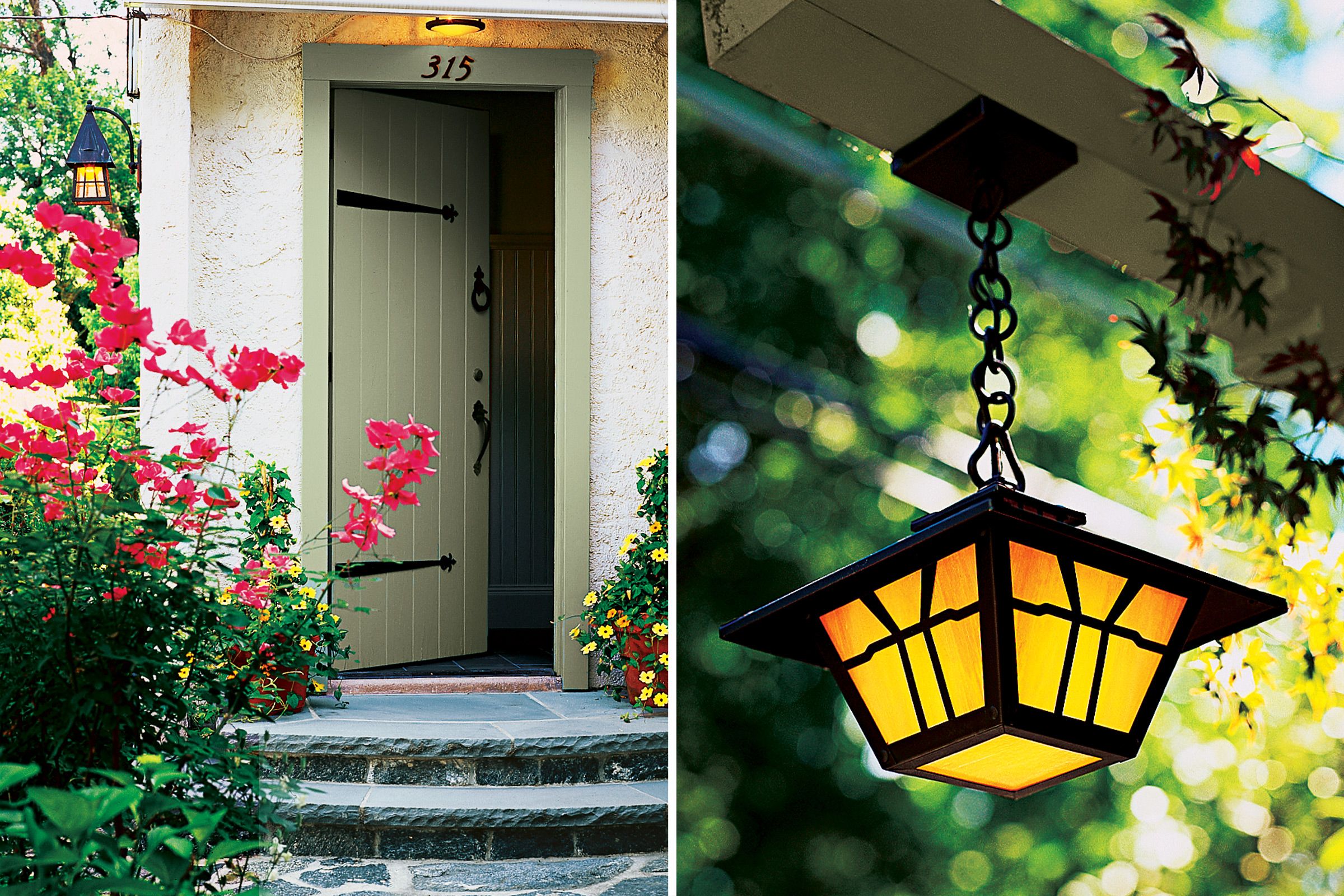
Tie the house into the garden
Create a seamless transition between your home and garden by repeating design elements. For example, use the same hardware style on your front door as on your garden gate. Paint garden structures the same color as your door for a cohesive look.
Expand your entrance area with a larger bluestone pad, providing space for potted plants. This creates a welcoming approach to your home and visually connects it to the surrounding landscape. Complement your garden’s theme with patio furniture in similar colors and materials to create a unified look.
Illuminate the evening
Proper lighting can transform your small yard after dark. Choose fixtures that complement your home’s architectural style. For a Tudor Revival cottage, consider bronze light fixtures with amber glass shades and warm-colored bulbs. Place lights strategically to highlight key features of your garden, such as ornamental trees or climbing roses.
Well-placed lighting not only enhances the beauty of your garden but also extends the time you can enjoy your outdoor space. Path lights, uplights, and string lights are all excellent choices for creating a warm and inviting ambiance.
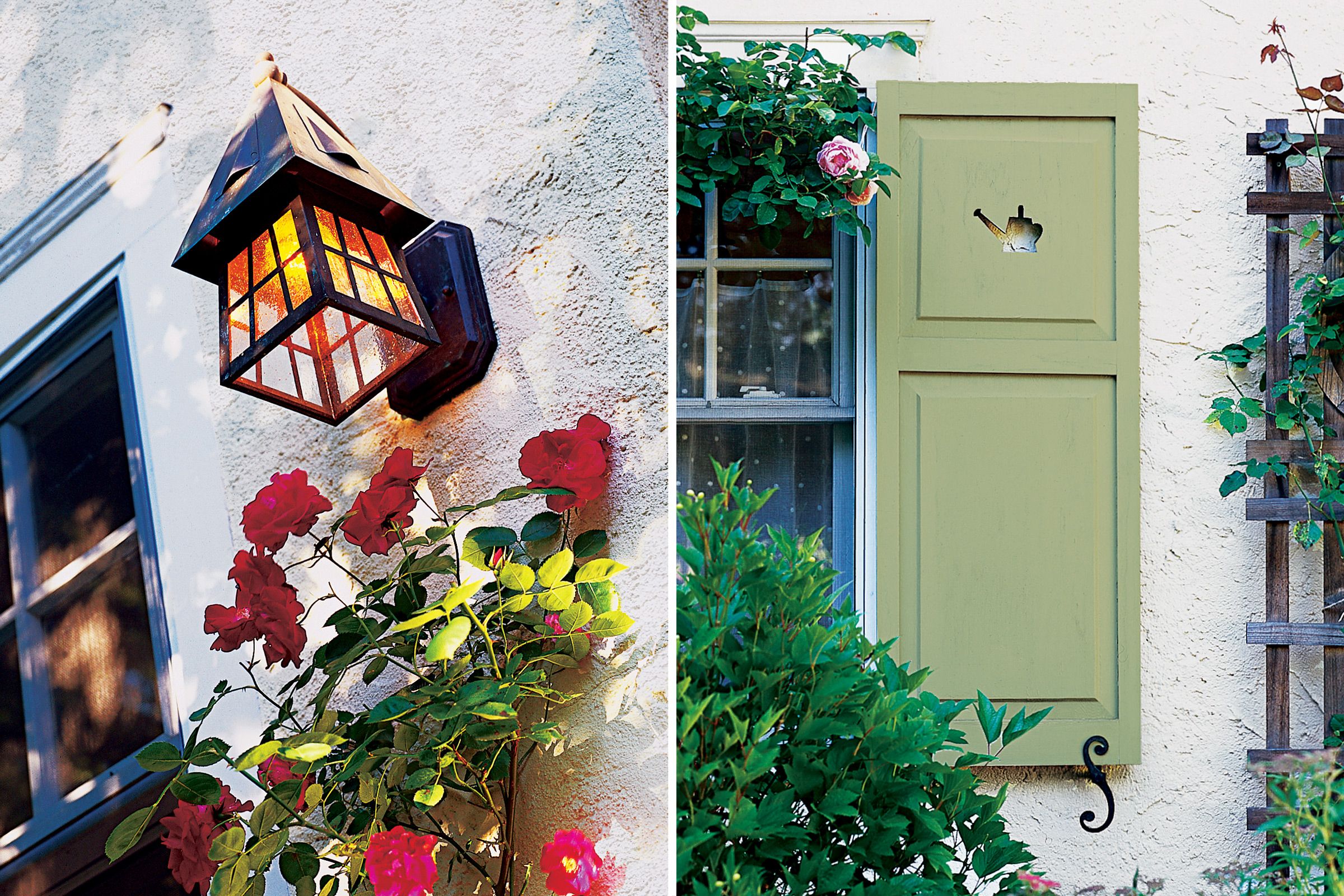
Create ambience
Thoughtful lighting placement can create a warm and inviting atmosphere in your garden. Consider placing lights near seating areas or along pathways to extend the usability of your outdoor space into the evening hours. Soft, indirect lighting can also accentuate the texture of plants and create interesting shadows. Outdoor lanterns and fairy lights are perfect for adding a cozy touch to garden parties or quiet nights outside.
Customize the details
Small details can make a big impact in a compact garden. Choose materials that weather well, such as cedar for trellises and other garden structures. Allow these elements to age naturally for a low-maintenance, timeless appearance. Think about incorporating water features or artistic sculptures to add personality and a focal point to your garden.
